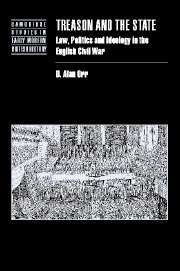Book contents
- Frontmatter
- Contents
- Acknowledgments
- List of abbreviations
- Introduction
- Part I Concepts
- Part II Practice
- 3 Thomas Wentworth, First Earl of Strafford
- 4 William Laud, Archbishop of Canterbury
- 5 Connor Lord Maguire, Second Baron of Enniskillen
- 6 Charles Stuart, King of England
- Conclusion
- Bibliography
- Index
- Cambridge Studies in Early Modern British History
6 - Charles Stuart, King of England
Published online by Cambridge University Press: 21 July 2009
- Frontmatter
- Contents
- Acknowledgments
- List of abbreviations
- Introduction
- Part I Concepts
- Part II Practice
- 3 Thomas Wentworth, First Earl of Strafford
- 4 William Laud, Archbishop of Canterbury
- 5 Connor Lord Maguire, Second Baron of Enniskillen
- 6 Charles Stuart, King of England
- Conclusion
- Bibliography
- Index
- Cambridge Studies in Early Modern British History
Summary
The trial of Charles Stuart, King of England in January 1649 attempted to legitimate the claims of the Rump Parliament on behalf of the emerging Commonwealth to be the sole wielders of sovereign power in England. The trial of the king was just one stage in what J. P. Kenyon has described as a “ragged and haphazard” process of constitutional revision beginning with the army's purge of the Long Parliament in December 1648 and culminating on 19 May 1649 with the passage by the Rump of an act declaring England “to be a Commonwealth and Free State.” This act stated further that England was “henceforth [to] be governed … by the supreme authority of this nation, the representatives of the people in Parliament, and by such as they shall appoint and constitute as officers and ministers under them for the good of the people … without any King, or House of Lords.” The redescription of England as a popular state in which the people were, according to the Commons' resolution of 4 January 1649, “under God, the original of all just power” was essential to the Commonwealths-men's endeavors to legitimate their actions.
Concomitantly, the king's status in relation to the body politic changed.
- Type
- Chapter
- Information
- Treason and the StateLaw, Politics and Ideology in the English Civil War, pp. 171 - 205Publisher: Cambridge University PressPrint publication year: 2002



